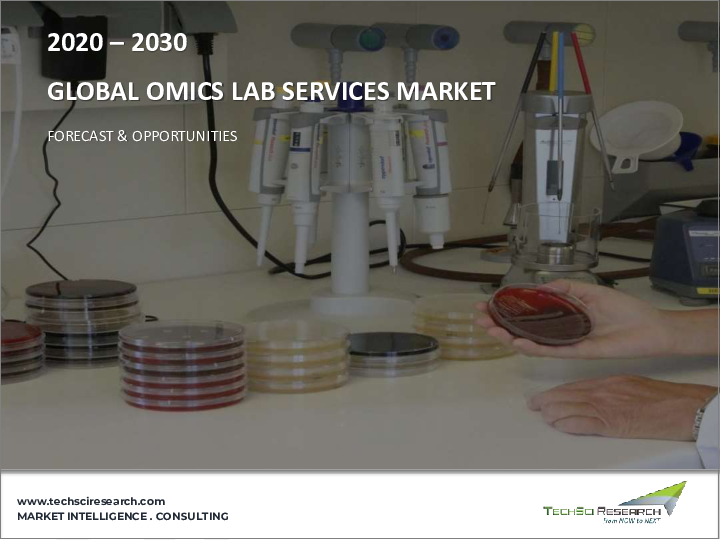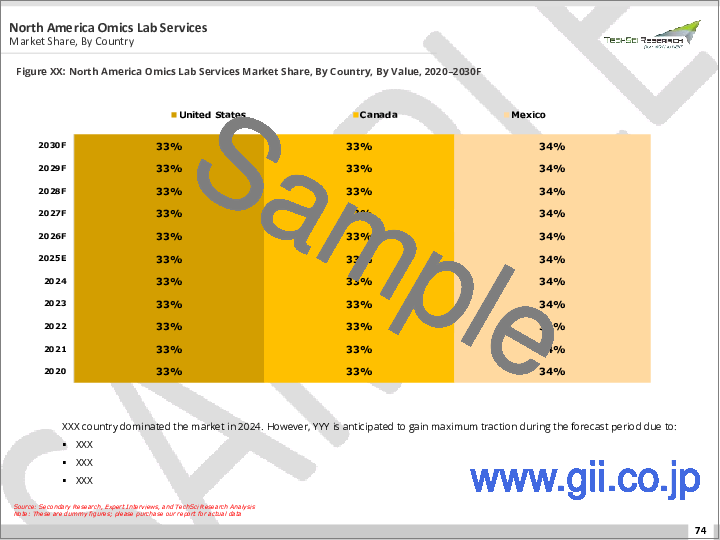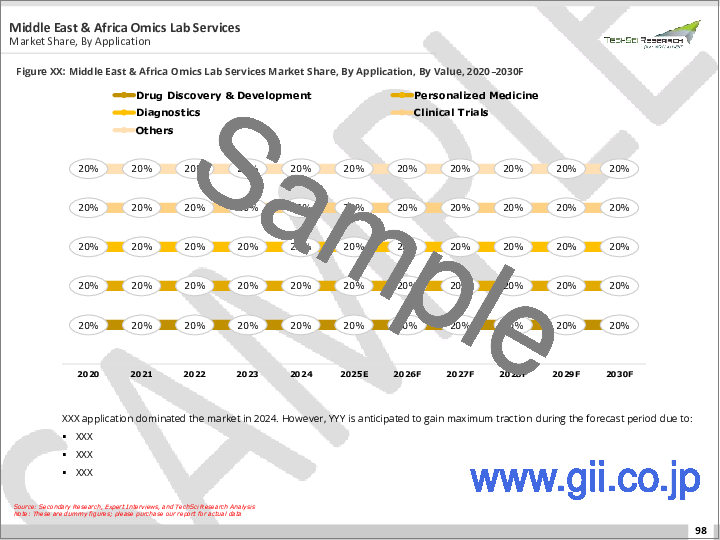|
|
市場調査レポート
商品コード
1714390
オミックス検査サービス市場- 世界の産業規模、シェア、動向、機会、予測、サービス別、サービス頻度別、事業別、エンドユース別、地域別、競合別、2020-2030年Omics Lab Services Market - Global Industry Size, Share, Trends, Opportunity, and Forecast, Segmented By Service, By Frequency Of Service, By Business, By End Use, By Region and Competition, 2020-2030F |
||||||
カスタマイズ可能
|
|||||||
| オミックス検査サービス市場- 世界の産業規模、シェア、動向、機会、予測、サービス別、サービス頻度別、事業別、エンドユース別、地域別、競合別、2020-2030年 |
|
出版日: 2025年04月25日
発行: TechSci Research
ページ情報: 英文 185 Pages
納期: 2~3営業日
|
全表示
- 概要
- 目次
オミックス検査サービスの世界市場規模は、2024年に725億1,000万米ドル、2030年には1,246億1,000万米ドルに達し、予測期間中のCAGRは9.44%で成長すると予測されています。
急速に進展するこの市場は、ゲノミクス、プロテオミクス、メタボロミクス、トランスクリプトミクス、エピジェネティクスにまたがり、複雑な生物学的システムの理解に重要な役割を果たしています。これらのサービスは、疾病診断、バイオマーカー探索、精密治療開発をサポートします。個別化医療に対する需要の高まり、ハイスループット・シーケンスの進歩、創薬、農業、環境科学などの分野におけるオミクスの利用の高まりが、市場の成長を後押ししています。技術の進化に伴い、オミックス検査サービスは現代科学とヘルスケアにおける応用と影響力を拡大し続けています。
| 市場概要 | |
|---|---|
| 予測期間 | 2026-2030 |
| 市場規模:2024年 | 725億1,000万米ドル |
| 市場規模:2030年 | 1,246億1,000万米ドル |
| CAGR:2025年~2030年 | 9.44% |
| 急成長セグメント | がん |
| 最大市場 | 北米 |
市場促進要因
臨床ワークフローへのゲノミクスデータの統合の拡大
主な市場課題
熟練専門家の不足
主要市場動向
個別化医療
目次
第1章 概要
第2章 調査手法
第3章 エグゼクティブサマリー
第4章 顧客の声
第5章 世界のオミックス検査サービス市場展望
- 市場規模・予測
- 金額別
- 市場シェア・予測
- サービス別(ゲノミクス、プロテオミクス、トランスクリプトミクス、メタボロミクス、エピジェネティクス)
- サービスの頻度(1回限り、繰り返し、継続)
- 業種別(病院、調査機関、診断ラボ)
- 用途別(がん、薬理学、生殖、その他の遺伝性疾患)地域別
- 企業別(2024)
- 地域別
- 市場マップ
第6章 北米のオミックス検査サービス市場展望
- 市場規模・予測
- 市場シェア・予測
- 北米:国別分析
- 米国
- カナダ
- メキシコ
第7章 欧州のオミックス検査サービス市場展望
- 市場規模・予測
- 市場シェア・予測
- 欧州:国別分析
- ドイツ
- 英国
- イタリア
- フランス
- スペイン
第8章 アジア太平洋地域のオミックス検査サービス市場展望
- 市場規模・予測
- 市場シェア・予測
- アジア太平洋地域:国別分析
- 中国
- インド
- 日本
- 南
- オーストラリア
第9章 南米のオミックス検査サービス市場展望
- 市場規模・予測
- 市場シェア・予測
- 南米:国別分析
- ブラジル
- アルゼンチン
- コロンビア
第10章 中東・アフリカのオミックス検査サービス市場展望
- 市場規模・予測
- 市場シェア・予測
- 中東・アフリカ:国別分析
- 南アフリカ
- サウジアラビア
- アラブ首長国連邦
第11章 市場力学
- 促進要因
- 課題
第12章 市場動向と発展
- 合併と買収
- 製品上市
- 最近の動向
第13章 ポーターのファイブフォース分析
- 業界内の競合
- 新規参入の可能性
- サプライヤーの力
- 顧客の力
- 代替品の脅威/サービス
第14章 競合情勢
- Agilent Technologies, Inc.
- Q2 Solutions LLC
- Flomics Biotech
- QIAGEN N.V.
- Thermo Fisher Scientific Inc.
- Illumina, Inc
- Quest Diagnostics Incorporated
- Phenoswitch Bioscience
- Spectrus Corporation
- BEIJING GENOMICS INSTITUTE.
第15章 戦略的提言
第16章 調査会社について・免責事項
The Global Omics Lab Services Market was valued at USD 72.51 billion in 2024 and is projected to reach USD 124.61 billion by 2030, growing at a CAGR of 9.44% during the forecast period. This rapidly advancing market spans genomics, proteomics, metabolomics, transcriptomics, and epigenetics, and plays a crucial role in understanding complex biological systems. These services support disease diagnosis, biomarker discovery, and precision treatment development. The increasing demand for personalized medicine, advancements in high-throughput sequencing, and rising use of omics in sectors such as drug discovery, agriculture, and environmental sciences are propelling market growth. As technologies evolve, omics lab services continue to expand their applications and influence in modern science and healthcare.
| Market Overview | |
|---|---|
| Forecast Period | 2026-2030 |
| Market Size 2024 | USD 72.51 Billion |
| Market Size 2030 | USD 124.61 Billion |
| CAGR 2025-2030 | 9.44% |
| Fastest Growing Segment | Cancer |
| Largest Market | North America |
Key Market Drivers
Growing Integration Of Genomics Data Into Clinical Workflows
The integration of genomics data into clinical workflows is transforming healthcare and driving significant growth in the Omics Lab Services Market. Genomic insights are reshaping disease diagnosis, risk assessment, and personalized treatment approaches. With increasing accessibility and affordability of genomic data, healthcare providers can now identify patient-specific genetic mutations and susceptibilities, allowing for more targeted and effective interventions. Technologies like high-throughput sequencing and advanced bioinformatics are streamlining the analysis and interpretation of complex datasets, making genomics integration into everyday clinical practices both feasible and beneficial. Omics service providers play a vital role in enabling this transition, delivering the analytical capabilities and expertise required to support precision medicine initiatives.
Key Market Challenges
Lack Of Skilled Professionals
A major challenge facing the Omics Lab Services Market is the shortage of skilled professionals capable of managing and interpreting complex omics data. The sector requires expertise across molecular biology, bioinformatics, and data analytics-fields where highly trained personnel are in short supply. Particularly in bioinformatics, the volume and complexity of data generated by omics platforms necessitate specialized skills in data mining, coding, and statistical analysis. This talent gap leads to data processing delays and limits the scalability of omics services. Furthermore, effective collaboration across interdisciplinary teams is essential, and the lack of professionals capable of bridging these domains impedes broader adoption and integration of omics into healthcare and research.
Key Market Trends
Personalized Medicine
Personalized medicine is a transformative trend reshaping the Omics Lab Services Market by customizing healthcare to individual genetic and molecular profiles. Omics technologies, particularly genomics and proteomics, enable healthcare providers to uncover disease markers and identify therapeutic targets unique to each patient. This is particularly impactful in oncology, where tumor-specific genetic analysis informs the selection of targeted therapies, improving outcomes and reducing adverse effects. Beyond cancer, personalized medicine is expanding into areas such as cardiology, neurology, and rare genetic disorders. The rise of direct-to-consumer genetic testing is further fueling public interest, empowering individuals to take a proactive approach to their health based on personal genetic insights.
Key Market Players
- Agilent Technologies, Inc.
- Q2 Solutions LLC
- Flomics Biotech
- QIAGEN N.V.
- Thermo Fisher Scientific Inc.
- Illumina, Inc
- Quest Diagnostics Incorporated
- Phenoswitch Bioscience
- Spectrus Corporation
- BEIJING GENOMICS INSTITUTE
Report Scope:
In this report, the Global Omics Lab Services Market has been segmented into the following categories, in addition to the industry trends which have also been detailed below:
Omics Lab Services Market, By Service:
- Genomics
- Proteomics
- Transcriptomics
- Metabolomics
- Epigenetics
Omics Lab Services Market, By Frequency Of Service:
- One-Off
- Repeat
- Continuous
Omics Lab Services Market, By Business:
- Hospitals
- Research Institutes
- Diagnostic Labs
Omics Lab Services Market, By End Use:
- Cancer
- Pharmaco
- Reproductive
- Other Genetic Disease
Omics Lab Services Market, By Region:
- North America
- United States
- Canada
- Mexico
- Europe
- France
- United Kingdom
- Italy
- Germany
- Spain
- Asia-Pacific
- China
- India
- Japan
- Australia
- South Korea
- South America
- Brazil
- Argentina
- Colombia
- Middle East & Africa
- South Africa
- Saudi Arabia
- UAE
Competitive Landscape
Company Profiles: Detailed analysis of the major companies present in the Global Omics Lab Services Market.
Available Customizations:
Global Omics Lab Services market report with the given market data, TechSci Research offers customizations according to a company's specific needs. The following customization options are available for the report:
Company Information
- Detailed analysis and profiling of additional market players (up to five).
Table of Contents
1. Product Overview
- 1.1. Market Definition
- 1.2. Scope of the Market
- 1.2.1. Markets Covered
- 1.2.2. Years Considered for Study
- 1.2.3. Key Market Segmentations
2. Research Methodology
- 2.1. Objective of the Study
- 2.2. Baseline Methodology
- 2.3. Key Industry Partners
- 2.4. Major Association and Secondary Sources
- 2.5. Forecasting Methodology
- 2.6. Data Triangulation & Validation
- 2.7. Assumptions and Limitations
3. Executive Summary
- 3.1. Overview of the Market
- 3.2. Overview of Key Market Segmentations
- 3.3. Overview of Key Market Players
- 3.4. Overview of Key Regions/Countries
- 3.5. Overview of Market Drivers, Challenges, and Trends
4. Voice of Customer
5. Global Omics Lab Services Market Outlook
- 5.1. Market Size & Forecast
- 5.1.1. By Value
- 5.2. Market Share & Forecast
- 5.2.1. By Service (Genomics, Proteomics, Transcriptomics, Metabolomics, Epigenetics)
- 5.2.2. By Frequency Of Service (One-Off, Repeat, Continuous)
- 5.2.3. By Business (Hospitals, Research Institutes, Diagnostic Labs)
- 5.2.4. By End Use (Cancer, Pharmaco, Reproductive, Other Genetic Disease) By Region
- 5.2.5. By Company (2024)
- 5.2.6. By Region
- 5.3. Market Map
6. North America Omics Lab Services Market Outlook
- 6.1. Market Size & Forecast
- 6.1.1. By Value
- 6.2. Market Share & Forecast
- 6.2.1. By Service
- 6.2.2. By Frequency of Service
- 6.2.3. By Business
- 6.2.4. By End Use
- 6.2.5. By Country
- 6.3. North America: Country Analysis
- 6.3.1. United States Omics Lab Services Market Outlook
- 6.3.1.1. Market Size & Forecast
- 6.3.1.1.1. By Value
- 6.3.1.2. Market Share & Forecast
- 6.3.1.2.1. By Service
- 6.3.1.2.2. By Frequency of Service
- 6.3.1.2.3. By Business
- 6.3.1.2.4. By End Use
- 6.3.1.1. Market Size & Forecast
- 6.3.2. Canada Omics Lab Services Market Outlook
- 6.3.2.1. Market Size & Forecast
- 6.3.2.1.1. By Value
- 6.3.2.2. Market Share & Forecast
- 6.3.2.2.1. By Service
- 6.3.2.2.2. By Frequency of Service
- 6.3.2.2.3. By Business
- 6.3.2.2.4. By End Use
- 6.3.2.1. Market Size & Forecast
- 6.3.3. Mexico Omics Lab Services Market Outlook
- 6.3.3.1. Market Size & Forecast
- 6.3.3.1.1. By Value
- 6.3.3.2. Market Share & Forecast
- 6.3.3.2.1. By Service
- 6.3.3.2.2. By Frequency of Service
- 6.3.3.2.3. By Business
- 6.3.3.2.4. By End Use
- 6.3.3.1. Market Size & Forecast
- 6.3.1. United States Omics Lab Services Market Outlook
7. Europe Omics Lab Services Market Outlook
- 7.1. Market Size & Forecast
- 7.1.1. By Value
- 7.2. Market Share & Forecast
- 7.2.1. By Service
- 7.2.2. By Frequency of Service
- 7.2.3. By Business
- 7.2.4. By End Use
- 7.2.5. By Country
- 7.3. Europe: Country Analysis
- 7.3.1. Germany Omics Lab Services Market Outlook
- 7.3.1.1. Market Size & Forecast
- 7.3.1.1.1. By Value
- 7.3.1.2. Market Share & Forecast
- 7.3.1.2.1. By Service
- 7.3.1.2.2. By Frequency of Service
- 7.3.1.2.3. By Business
- 7.3.1.2.4. By End Use
- 7.3.1.1. Market Size & Forecast
- 7.3.2. United Kingdom Omics Lab Services Market Outlook
- 7.3.2.1. Market Size & Forecast
- 7.3.2.1.1. By Value
- 7.3.2.2. Market Share & Forecast
- 7.3.2.2.1. By Service
- 7.3.2.2.2. By Frequency of Service
- 7.3.2.2.3. By Business
- 7.3.2.2.4. By End Use
- 7.3.2.1. Market Size & Forecast
- 7.3.3. Italy Omics Lab Services Market Outlook
- 7.3.3.1. Market Size & Forecast
- 7.3.3.1.1. By Value
- 7.3.3.2. Market Share & Forecast
- 7.3.3.2.1. By Service
- 7.3.3.2.2. By Frequency of Service
- 7.3.3.2.3. By Business
- 7.3.3.2.4. By End Use
- 7.3.3.1. Market Size & Forecast
- 7.3.4. France Omics Lab Services Market Outlook
- 7.3.4.1. Market Size & Forecast
- 7.3.4.1.1. By Value
- 7.3.4.2. Market Share & Forecast
- 7.3.4.2.1. By Service
- 7.3.4.2.2. By Frequency of Service
- 7.3.4.2.3. By Business
- 7.3.4.2.4. By End Use
- 7.3.4.1. Market Size & Forecast
- 7.3.5. Spain Omics Lab Services Market Outlook
- 7.3.5.1. Market Size & Forecast
- 7.3.5.1.1. By Value
- 7.3.5.2. Market Share & Forecast
- 7.3.5.2.1. By Service
- 7.3.5.2.2. By Frequency of Service
- 7.3.5.2.3. By Business
- 7.3.5.2.4. By End Use
- 7.3.5.1. Market Size & Forecast
- 7.3.1. Germany Omics Lab Services Market Outlook
8. Asia-Pacific Omics Lab Services Market Outlook
- 8.1. Market Size & Forecast
- 8.1.1. By Value
- 8.2. Market Share & Forecast
- 8.2.1. By Service
- 8.2.2. By Frequency of Service
- 8.2.3. By Business
- 8.2.4. By End Use
- 8.2.5. By Country
- 8.3. Asia-Pacific: Country Analysis
- 8.3.1. China Omics Lab Services Market Outlook
- 8.3.1.1. Market Size & Forecast
- 8.3.1.1.1. By Value
- 8.3.1.2. Market Share & Forecast
- 8.3.1.2.1. By Service
- 8.3.1.2.2. By Frequency of Service
- 8.3.1.2.3. By Business
- 8.3.1.2.4. By End Use
- 8.3.1.1. Market Size & Forecast
- 8.3.2. India Omics Lab Services Market Outlook
- 8.3.2.1. Market Size & Forecast
- 8.3.2.1.1. By Value
- 8.3.2.2. Market Share & Forecast
- 8.3.2.2.1. By Service
- 8.3.2.2.2. By Frequency of Service
- 8.3.2.2.3. By Business
- 8.3.2.2.4. By End Use
- 8.3.2.1. Market Size & Forecast
- 8.3.3. Japan Omics Lab Services Market Outlook
- 8.3.3.1. Market Size & Forecast
- 8.3.3.1.1. By Value
- 8.3.3.2. Market Share & Forecast
- 8.3.3.2.1. By Service
- 8.3.3.2.2. By Frequency of Service
- 8.3.3.2.3. By Business
- 8.3.3.2.4. By End Use
- 8.3.3.1. Market Size & Forecast
- 8.3.4. South Omics Lab Services Market Outlook
- 8.3.4.1. Market Size & Forecast
- 8.3.4.1.1. By Value
- 8.3.4.2. Market Share & Forecast
- 8.3.4.2.1. By Service
- 8.3.4.2.2. By Frequency of Service
- 8.3.4.2.3. By Business
- 8.3.4.2.4. By End Use
- 8.3.4.1. Market Size & Forecast
- 8.3.5. Australia Omics Lab Services Market Outlook
- 8.3.5.1. Market Size & Forecast
- 8.3.5.1.1. By Value
- 8.3.5.2. Market Share & Forecast
- 8.3.5.2.1. By Service
- 8.3.5.2.2. By Frequency of Service
- 8.3.5.2.3. By Business
- 8.3.5.2.4. By End Use
- 8.3.5.1. Market Size & Forecast
- 8.3.1. China Omics Lab Services Market Outlook
9. South America Omics Lab Services Market Outlook
- 9.1. Market Size & Forecast
- 9.1.1. By Value
- 9.2. Market Share & Forecast
- 9.2.1. By Service
- 9.2.2. By Frequency of Service
- 9.2.3. By Business
- 9.2.4. By End Use
- 9.2.5. By Country
- 9.3. South America: Country Analysis
- 9.3.1. Brazil Omics Lab Services Market Outlook
- 9.3.1.1. Market Size & Forecast
- 9.3.1.1.1. By Value
- 9.3.1.2. Market Share & Forecast
- 9.3.1.2.1. By Service
- 9.3.1.2.2. By Frequency of Service
- 9.3.1.2.3. By Business
- 9.3.1.2.4. By End Use
- 9.3.1.1. Market Size & Forecast
- 9.3.2. Argentina Omics Lab Services Market Outlook
- 9.3.2.1. Market Size & Forecast
- 9.3.2.1.1. By Value
- 9.3.2.2. Market Share & Forecast
- 9.3.2.2.1. By Service
- 9.3.2.2.2. By Frequency of Service
- 9.3.2.2.3. By Business
- 9.3.2.2.4. By End Use
- 9.3.2.1. Market Size & Forecast
- 9.3.3. Colombia Omics Lab Services Market Outlook
- 9.3.3.1. Market Size & Forecast
- 9.3.3.1.1. By Value
- 9.3.3.2. Market Share & Forecast
- 9.3.3.2.1. By Service
- 9.3.3.2.2. By Frequency of Service
- 9.3.3.2.3. By Business
- 9.3.3.2.4. By End Use
- 9.3.3.1. Market Size & Forecast
- 9.3.1. Brazil Omics Lab Services Market Outlook
10. Middle East and Africa Omics Lab Services Market Outlook
- 10.1. Market Size & Forecast
- 10.1.1. By Value
- 10.2. Market Share & Forecast
- 10.2.1. By Service
- 10.2.2. By Frequency of Service
- 10.2.3. By Business
- 10.2.4. By End Use
- 10.2.5. By Country
- 10.3. MEA: Country Analysis
- 10.3.1. South Africa Omics Lab Services Market Outlook
- 10.3.1.1. Market Size & Forecast
- 10.3.1.1.1. By Value
- 10.3.1.2. Market Share & Forecast
- 10.3.1.2.1. By Service
- 10.3.1.2.2. By Frequency of Service
- 10.3.1.2.3. By Business
- 10.3.1.2.4. By End Use
- 10.3.1.1. Market Size & Forecast
- 10.3.2. Saudi Arabia Omics Lab Services Market Outlook
- 10.3.2.1. Market Size & Forecast
- 10.3.2.1.1. By Value
- 10.3.2.2. Market Share & Forecast
- 10.3.2.2.1. By Service
- 10.3.2.2.2. By Frequency of Service
- 10.3.2.2.3. By Business
- 10.3.2.2.4. By End Use
- 10.3.2.1. Market Size & Forecast
- 10.3.3. UAE Omics Lab Services Market Outlook
- 10.3.3.1. Market Size & Forecast
- 10.3.3.1.1. By Value
- 10.3.3.2. Market Share & Forecast
- 10.3.3.2.1. By Service
- 10.3.3.2.2. By Frequency of Service
- 10.3.3.2.3. By Business
- 10.3.3.2.4. By End Use
- 10.3.3.1. Market Size & Forecast
- 10.3.1. South Africa Omics Lab Services Market Outlook
11. Market Dynamics
- 11.1. Drivers
- 11.2. Challenges
12. Market Trends & Developments
- 12.1. Merger & Acquisition (If Any)
- 12.2. Product Launches (If Any)
- 12.3. Recent Developments
13. Porters Five Forces Analysis
- 13.1. Competition in the Industry
- 13.2. Potential of New Entrants
- 13.3. Power of Suppliers
- 13.4. Power of Customers
- 13.5. Threat of Substitute Products/Services
14. Competitive Landscape
- 14.1. Agilent Technologies, Inc.
- 14.1.1. Business Overview
- 14.1.2. Company Snapshot
- 14.1.3. Products & Services
- 14.1.4. Financials (As Reported)
- 14.1.5. Recent Developments
- 14.1.6. Key Personnel Details
- 14.1.7. SWOT Analysis
- 14.2. Q2 Solutions LLC
- 14.3. Flomics Biotech
- 14.4. QIAGEN N.V.
- 14.5. Thermo Fisher Scientific Inc.
- 14.6. Illumina, Inc
- 14.7. Quest Diagnostics Incorporated
- 14.8. Phenoswitch Bioscience
- 14.9. Spectrus Corporation
- 14.10. BEIJING GENOMICS INSTITUTE.




